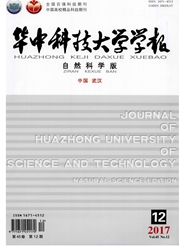

 中文摘要:
中文摘要:
从化学反应动力学角度,基于实验数据选择了最佳基元反应模型,采用CHEMKIN软件包研究了O2/CO2气氛及空气气氛下甲烷火焰中NOx前驱物的转化机理,探讨了多种影响因素对NOx前驱物转化过程的影响规律,比较了2种气氛下NOx前驱物转化机理的异同,考察了重要基元反应在2种气氛下生成率的区别以及高体积分数CO2气氛对主要基元反应的影响,得到了不同气氛下NOx前驱物的转化历程,从微观反应动力学的角度解释了2种气氛下NOx前驱物转化行为的差异.结果表明NOx前驱物HCN和NH3在2种气氛下的反应历程是不相同的.其中:O2/CO2气氛富燃条件下NOx前驱物的主要转化历程为HCN→NCO→N2O→N2,NH3→NH2→N2;O2/CO2气氛贫燃条件下NOx前驱物的主要反应历程为HCN→NCO→N2O→N2,NH3→NH2→NNH→N2.
 英文摘要:
英文摘要:
Most studies find significantly lower NO, emissions during oxy-coal combustion. Methane (CH4) was used as fuel, with hydrogen cyanide (HCN) and ammonia (NH3) being added as fuel-ni- trogen sources. Numerical simulations using Chemkin to model N-conversion through homogeneous gas phase reactions were reported. A suitable reaction mechanism was chosen based on comparison of the calculations to experimental data which accurately predicts NO concentrations over the range of equivalence ratios. The influence of various parameters (temperature, pressure, equivalence ratio, CO2 concentration) on NO formation was investigated. The effects of high concentration of CO2 were emphasized through mechanism analysis. In addition, a sensitivity analysis was performed in an attempt to identify the most important reactions pertinent under the relevant conditions of study. According to this study, under O2/CO2 atmosphere, NOw precursors mainly proceeds via reaction: HC→NCO→ N2O→N2, and NH3→NH2→N2 (fuel-rich condition), while conversion of NOx precursors mainly pro- ceeds via reaction: HCN→NCO→N2O→N2, and NH3→NH2→NNH→N2 (fuel-lean condition).
 同期刊论文项目
同期刊论文项目
 同项目期刊论文
同项目期刊论文
 Microwave-induced Catalytic Oxidation of RhB by a Nanocomposite of Fe@Fe2O3 Core#Shell Nanowires and
Microwave-induced Catalytic Oxidation of RhB by a Nanocomposite of Fe@Fe2O3 Core#Shell Nanowires and Experimental research and characteristics analysis of alumina-supported copper oxide sorbent for flu
Experimental research and characteristics analysis of alumina-supported copper oxide sorbent for flu Development ofan inverse method to simulate heavy metal vaporization kinetics from coal in a fluidiz
Development ofan inverse method to simulate heavy metal vaporization kinetics from coal in a fluidiz Combustion Modeling of Blended Coal in a 300MW Tangentially-firing Boiler with a Three-mixture-fract
Combustion Modeling of Blended Coal in a 300MW Tangentially-firing Boiler with a Three-mixture-fract An Improved Petrov-Galerkin Spectral Collocation Solution for Linear Stability of Circular Jet, CMES
An Improved Petrov-Galerkin Spectral Collocation Solution for Linear Stability of Circular Jet, CMES A Special Issue on 2009 Sino-Australian Symposium on Advanced Coal and Biomass Utilisation Technolog
A Special Issue on 2009 Sino-Australian Symposium on Advanced Coal and Biomass Utilisation Technolog An economic feasibility study of O2/CO2 recycle combustion technology based on existing coal-fired p
An economic feasibility study of O2/CO2 recycle combustion technology based on existing coal-fired p Relationship between nitrogenous species in coals and volatile nitrogen-containing yields during pyr
Relationship between nitrogenous species in coals and volatile nitrogen-containing yields during pyr An investigation of the causes of the difference in coal particle ignition temperature between combu
An investigation of the causes of the difference in coal particle ignition temperature between combu Effect of cellulose, lignin, alkali and alkaline earth metallic species on biomass pyrolysis and gas
Effect of cellulose, lignin, alkali and alkaline earth metallic species on biomass pyrolysis and gas Physical quantity synergy in the field of turbulent heat transfer and its analysis for heat transfer
Physical quantity synergy in the field of turbulent heat transfer and its analysis for heat transfer The effects of coal blending on the formation and properties of particulate matter during combustion
The effects of coal blending on the formation and properties of particulate matter during combustion The Solution of Transient Riadative Transfer with Collimated Incident Serial Pulse in a Plane-Parall
The Solution of Transient Riadative Transfer with Collimated Incident Serial Pulse in a Plane-Parall Optimization of combustion based on introducing radiant energy signal in pulverized coal-fired boile
Optimization of combustion based on introducing radiant energy signal in pulverized coal-fired boile A compact optimization strategy for combustion in a 125 MW tangentially anthracite-fired boiler by a
A compact optimization strategy for combustion in a 125 MW tangentially anthracite-fired boiler by a Volatilization behavior of Cd and Zn based on continuous emission measurement of flue gas from labor
Volatilization behavior of Cd and Zn based on continuous emission measurement of flue gas from labor Numerical simulations of the slagging characteristics in a down-fired, pulverized-coal boiler furnac
Numerical simulations of the slagging characteristics in a down-fired, pulverized-coal boiler furnac A pilot scale study on co-capture of SO2 and NOx in O-2/CO2 recycled coal combustion and techno-econ
A pilot scale study on co-capture of SO2 and NOx in O-2/CO2 recycled coal combustion and techno-econ Pyrolysis of maize stalk on the characterization of chars formed under different devolatilization co
Pyrolysis of maize stalk on the characterization of chars formed under different devolatilization co Effects of Indigenous and Added Minerals on Transformation of Organic and Inorganic Sulfur in Densit
Effects of Indigenous and Added Minerals on Transformation of Organic and Inorganic Sulfur in Densit Mineralogy and chemical composition of high calcium fly ashes and density fractions from a coal-fire
Mineralogy and chemical composition of high calcium fly ashes and density fractions from a coal-fire Study of flow mechanism and heat transfer enhancement in longitudinal-flow tube bundle of shell-and-
Study of flow mechanism and heat transfer enhancement in longitudinal-flow tube bundle of shell-and- The Formation and Emission of Particulate Matter during the Combustion of Density Separated Coal Fra
The Formation and Emission of Particulate Matter during the Combustion of Density Separated Coal Fra An efficient solution for linear stability of circular jet: A combination of Petrov-Galerkin spectra
An efficient solution for linear stability of circular jet: A combination of Petrov-Galerkin spectra Physical quantity synergy in laminar flow field of convective heat transfer and analysis of heat tra
Physical quantity synergy in laminar flow field of convective heat transfer and analysis of heat tra 期刊信息
期刊信息
